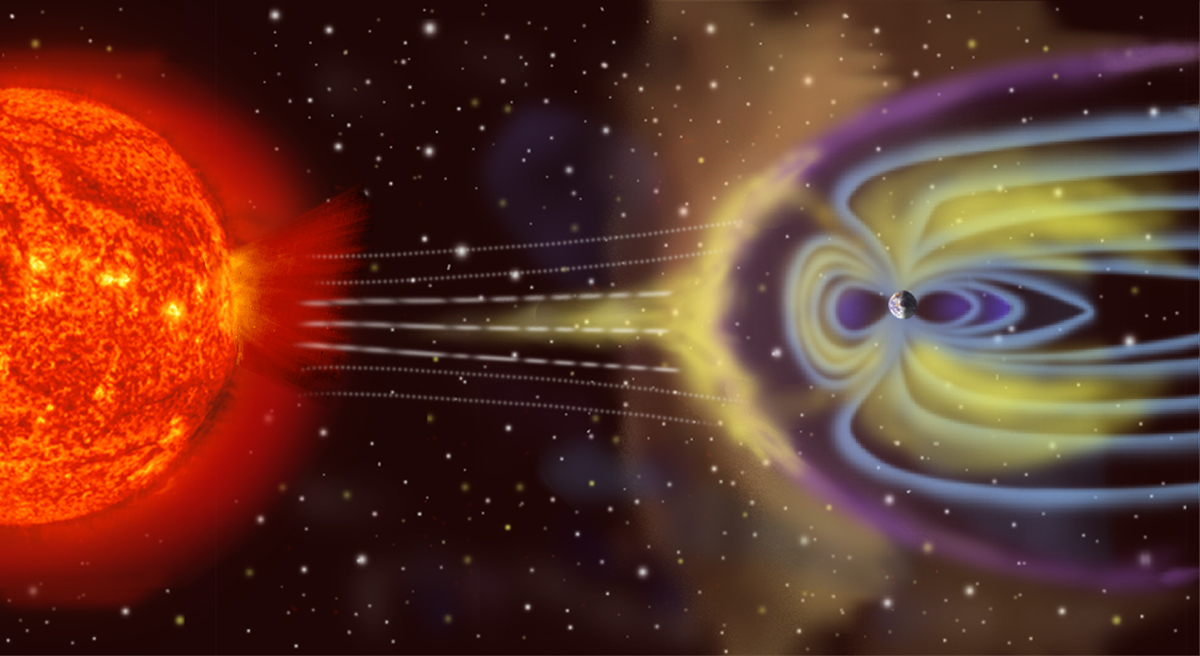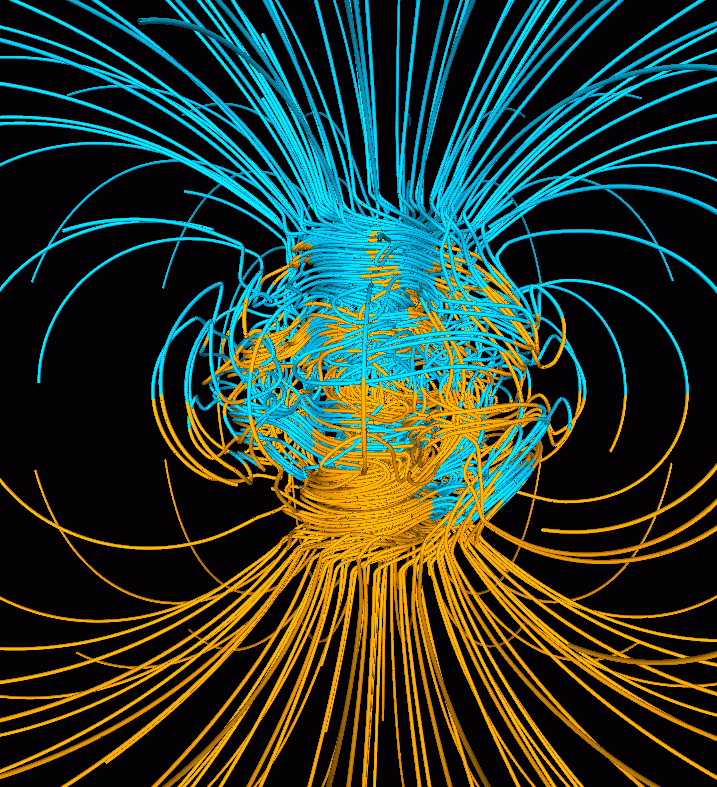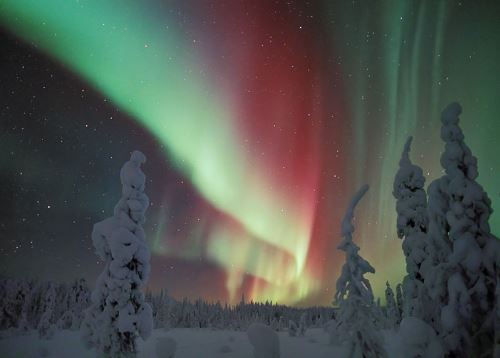Imagine for a moment that you are a proton. You are a very tiny particle, less than a millionth of a billionth of a metre wide. You possess a positive electrical charge, which means these three things are true about you:
- You are pushed away from other positive charges,
- You are pulled towards negative charges, and
- When you move, you act a little bit like a magnet.
Although you are very small, you are a member of a rather large club. Around you are a little more than an octodecillion other protons. That’s a very large number indeed. Where on Earth could so many protons gather together? Nowhere on Earth at all. You are part of the Sun. Besides protons, there are about the same number of negatively charged electrons in the Sun (as well as a good number of neutrons). For small bits of time you are able to hold onto an electron with your positive charge and you become a Hydrogen atom for a moment. When this happens, some of the electron’s energy flies out as a flash of light. Alas, eventually you are given a hard kick by a fast moving particle or by another flash of light, which knocks your electron away from you again. You are a part of a glowing soup of protons and electrons, that can never manage to stay together for long, called a plasma. This has been your life for the past 4.5 billion years or so, but things are about to change dramatically.
You and all the other protons and electrons in the Sun are moving around very fast, which makes the Sun act like a gigantic magnet. Regular iron magnets, like the ones on a refrigerator, have pretty simple magnetic fields that don’t change much on their own. But the Sun is not at all a regular magnet. Because all of the charged particles are constantly moving, so is the magnetic field of the Sun. Sometimes it’s calm and gentle, but sometimes it’s violently active—powerful enough to blast charged particles like you far away into deep space.
Today is one of those days. Suddenly, you feel an incredible push from beneath you, not like the little kicks from other particles that you are used to—this push doesn’t fade away. The push keeps pushing and pushing, lifting you up into the corona of the Sun, where you form part of a flare. You follow the path of the magnetic field until finally the push explodes beneath you like a bomb, sending you flying out beyond the Sun and away from your octodecillion other proton neighbours. This is a coronal mass ejection. You’re used to moving very fast, but you have always been jostled back and forth, never able to cover any real distance. Now you’re on a one-way journey through the solar system as part of what is known as the solar wind.

As you hurtle through space, much faster than any human-created rocket, you see a pale blue dot far in the distance. It's moving through space as well, and your two paths seem to be heading towards the same point. As you and the dot get closer to one another, it begins to look like a marble, then a giant ball, then the planet Earth. You are flying straight in towards the equator. Since you are a positively charged proton, you see the Earth in a very different way from how humans see it. Like the Sun, the Earth has a magnetic field. It isn’t quite as active or violent as the Sun’s, but due to Earth's churning, seething, molten metal core, the magnetic field is also complex and constantly changing.
You are a charged particle and you are moving, which means you can see these magnetic fields and you are influenced by them. After just a few days of travelling in a perfectly straight line away from the Sun, you once again feel the familiar tug of magnetism as you become bound to a field line like a roller coaster cart bound to the rail.

Though you can't see the whole field at once from a distance, you can tell from subtle influences that the Earth’s magnetic field bows far out, away from the planet at the equator. As each line of the magnetic field nears the North or South pole it comes right down into the planet's atmosphere and through the Earth itself, winding and twisting through the molten core and emerging from the opposite pole, ultimately forming a loop and reconnecting to itself. Long before you reach the atmosphere of the Earth, you feel yourself impelled north, towards the Arctic pole. Some of the particles that have been travelling along with you—fellow components of the solar wind, are swept south towards the Antarctic. None of the charged particles can escape the magnetic field, which is a good thing for the inhabitants of Earth. A constant stream of charged particles travelling at such high speed would cause a great deal of damage to the plants, animals and other living things near the surface of the Earth.
Your magnetic field line plunges into Earth’s atmosphere, about 100 kilometres above the surface, and you arrive somewhere over Norway. You and your solar wind companions start to whiz past the molecules of Nitrogen and Oxygen in the thin air of the ionosphere, when something amazing happens. Right next to you, another proton smacks directly into an Oxygen atom, imparting 6 kiloelectronvolts of energy into the particle. At human scales, this is an incredibly tiny bit of energy, about a billionth of a billionth of the energy gained by eating a single grain of flour, but to an atom, it is more than enough to kick away one of the electrons surrounding the Oxygen nucleus.
In fact, this is very similar to the kicks that you experienced back on the Sun. In this much cooler environment of Earth’s atmosphere, the standard is for electrons and protons to be bound together in atoms, so before long, the free electron (or another, identical one) finds its way back to the Oxygen atom. As this electron settles into a comfortable low-energy position, it releases some of the energy that it gained from the kick. This energy comes out as a single photon—a particle of light in a beautiful scarlet red hue. You witness this process happening not once, but billions upon billions of times. The solar wind collides with the atmospheric gasses, creating a cascade of energetic charged ions which quickly settle back down, releasing their energy as a soft glow of flowing, shimmering colours.
Reds way up high, and greens farther down towards the surface are created by Oxygen—the different colours result from electrons settling into different energy levels as they fall back into their atoms. Where these two colours overlap, they blend to form orange and yellow bands. Excited Nitrogen atoms glow with a soft blue colour which mixes with the others, giving pink and purple fringes to the flowing curtains of light. The streams and ribbons of colour seem to move and dance through the air as a result of the interaction between the shifting currents of solar wind and the fluctuating magnetic field of the Earth. This spectacular light show is called Aurora Borealis, a name which comes from two gods of the ancient world: Aurora, the goddess of the dawn, and Boreas, god of the north wind. Today, we translate “Aurora Borealis” as “the Northern Lights.” There is a counterpart on the opposite side of the Earth called Aurora Australis (Southern Lights) caused by the particles of solar wind which follow the magnetic field lines toward the South pole.

Finally, your own path sends you flying directly into a Nitrogen atom, slowing your descent and kicking off an electron. This time, you manage to grab the electron yourself, where it settles into a comfortable, stable orbit by emitting a single photon of light into the northern sky. You enjoy the rest of the Aurora Borealis light show as you drift on the gentle breeze. No longer a lone charged ion in the solar wind, you are now the nucleus of a Hydrogen atom, at home in the familiar terrestrial winds of Earth's atmosphere.
Your journey from the Sun to the Earth is complete but you, proton, have a very long life still to lead (you will outlive the Earth, the Sun and the all the stars in all the galaxies). Perhaps in the near future you will meet an Oxygen atom and combine to form a molecule of water. You might condense into a raindrop, fall into a lake and eventually be consumed by a thirsty person. Becoming part of the person’s body, you may find yourself in a cell of their retina where there is a possibility of helping that person to see another instance of the Aurora Borealis. If that person has studied a bit of science, they may even take a moment to appreciate the fact that some of the particles making up their own body almost certainly came to them by a solar wind and at one time a piece of themselves helped to create a majestic, magnetic shower of light in the northern night sky.
Did you know? Wednesday, November 25, 2015 is the 100th anniversary of Albert Einstein's publication of the General Theory of Relativity. Celebrate by exploring why his theory is so important.